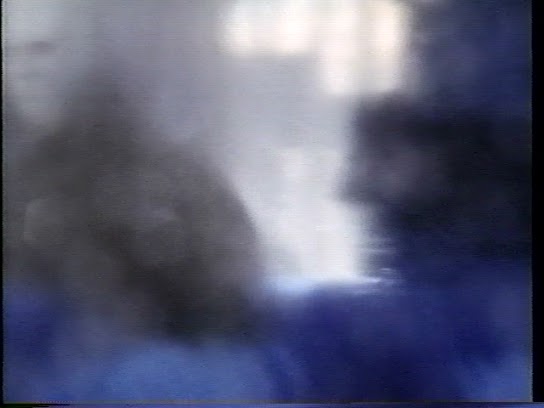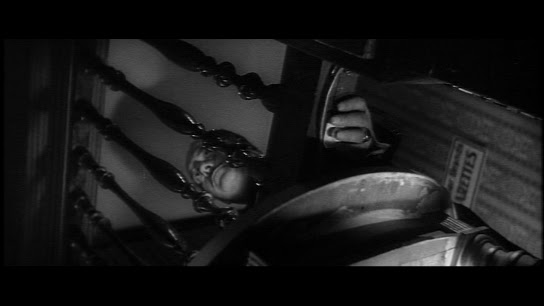Alfred Dawson (Ramiro Oliveros) is a writer who is being
plagued by nightmares of a young woman (Emma Cohen) beckoning for his help as
she is being attacked by a group of Templar knights. Dawson does not know if the dreams are a
premonition or the result of his now regular hashish use. Maria (Carmen Sevilla) loves Dawson very much
but she does not believe that he truly loves her. Dawson receives a letter from his sister,
Justine (Mónica Randall), from Spain, detailing her fear that her husband’s
drinking has become violent. She
desperately wants Dawson to visit her.
Unbeknownst to Dawson and to her husband, Enrique (Eduardo Fajardo),
Justine has been making the beast with two backs with her husband’s secretary,
Cesar (Adolfo Marsillach). She calls off
the affair; and upon arrival in Spain, Dawson learns that Justine has been
murdered. Her corpse was found at an old
monastery which houses the Cross of the Devil.
It is a region loathed by all that live near it. A suspect has been captured and is sitting in
jail; but Dawson believes there is more to her murder. The answer lies in the fearful region in the
mountains where on All Saints Day it is rumored the knights Templar rise from
the grave.

La cruz del diablo
(The Cross of the Devil) (1974) pales
in comparison to Amando de Ossorio’s Tombs
of the Blind Dead (1972), the quintessential horror film about the Templar
knights (also a quintessential European cult horror film). La cruz
is sluggishly paced and extremely talky.
The film only really starts cooking in the final act when Dawson has
convinced Cesar and Enrique to accompany him to the old monastery on Hallows’
Eve. Even during the final act,
sequences, like the swordfight confrontation with the Templars, are haphazard
and poor. The director, John Gilling,
helmed some interesting flicks prior to La
cruz such as Hammer films, The Plague
of the Zombies (1966) and The Mummy’s
Shroud (1967). The pacing and
atmosphere of La cruz had the
potential to be adeptly handled by Gilling.
Here’s an example: Dawson, Maria,
Cesar, and Enrique stop at an inn en route to the monastery. The inn is run by Ignacio (Fernando Sancho)
and young Ines (Silvia Vivó). Ines gives
bedroom eyes to Dawson while serving dinner.
After most have retired to bed, Dawson confronts Ines and asks if she
knows anything about the murder of his sister.
As an inducement, Dawson offers her a ruby ring for her information. She agrees to tell him what she knows in her
room later. Ines attempts to seduce
Dawson but he holds steadfast and demands to hear her story.

She says she saw the murder but cannot
identify the assassin. Dawson demands
that she accompany him to the monastery that very evening, although it is
late. The couple are halted in their
journey when Dawson has a vision of Justine being chased by Templars. Back at the inn, Ines is murdered in her bed,
wearing the ruby ring that Dawson gave her.
Not only does this lengthy, mechanical sequence pad the running time of
the film, but it also shows the missed opportunities by the crew of La cruz:
there is nothing sexy about Ines’s seduction scene; Dawson’s vision of
Justine is mere seconds and wholly uninteresting on a visual level; and
finally, Ines’s murder serves only as a denouement for the final act. The execution of the murder, like Dawson’s
vision of Justine, lacks any pizazz or fervor.
The cardinal sin committed in La
cruz is the underutilization of both Sevilla and Cohen, two of the finest
actresses working in Spain at the time.
To have cast them and not made them focal was a serious error in
judgment. Sevilla’s character has little
dramatic weight, and Cohen, like Sevilla, has precious little screen time.

Successful films have multiple parents, and failures are
orphans. I will conclude this review
with three quotes from Paul Naschy, the credited co-screenwriter of La cruz del Diablo with Juan José
Porto. I will list them in order of
their brevity as Naschy echoes the same sentiments in all three:
“I had a project some time ago in which I attempted to bring
the legends of Gustavo Adolfo Bécquer to the screen, but this project was
ruined by both Juan José Porto and an English director, John Gilling, who
didn’t know enough about them to be able to rise to the occasion. They cheated me and took over full control of
the script just because I had signed a contract which read as though they had
acquired it outright. They changed
everything, and the result was La cruz
del Diablo which had little to do with what I originally envisioned. The film was a complete fiasco, which is a
pity because it could have been a great opportunity for doing a genuinely
Spanish horror film.” (Videooze. Number 6/7.
Fall 1994. Ed. Bob Sargent. Alexandria, VA. p. 17.)
“The marvelous idea occurred to me of bringing the legends
of Gustavo Adolfo Bécquer to the screen.
Becquer represented to me the best poet in Spanish history, and
furthermore, they were wonderful Spanish tales of terror. I chose three legends: ‘La Cruz del Diablo,’ El Monte de las
Animas,’ and ‘Maese Pérez, el Organista,’ and I wrote a very complicated
script. The actors I had in mind for the
film were Peter Cushing, Samantha Eggar, Barbara Steele and James Franciscus; I
had already contacted some of them, and they were willing to do the film. When Enrique Herreros (an associate of Juan
José Porto) came to see me, he told me that in order for him to be able to move
ahead with the picture, he needed to have a contract in which I yielded the
script to him. After some doubts, I
signed the script over to him, which immediately left me on the outside. John Gilling then threw me off the film, and
so I was left without a script, without a role, and without a film. I brought a lawsuit against them and won two
things: 1) that they would pay me for the script, and 2) that my name would
appear in the credits. The latter I
regretted since they destroyed the script.
“The film, unfortunately, is one of my major
frustrations. Even today I would give
anything to be able to bring Gustavo Adolfo Bécquer to the screen, and it’s
possible that I may attempt to do so.” (Videooze. Number 6/7.
Fall 1994. Ed. Bob Sargent. Alexandria, VA. pp. 30-31.)

“In 1974 I suffered one of the most traumatic and depressing
experiences of my career. I had always
loved writer Gustavo Adolfo Bécquer’s Leyendas
and I came up with the idea of making a totally indigenous horror fantasy movie
by adapting some of Bécquer’s works for the big screen. The tales I chose were El miserere, El monte de las
ánimas and La cruz del diablo. I set to work and wrote a script which took
me a long time and a lot of effort. At
last I was satisfied and offered it to John Gilling, a workmanlike director who
could lay claim to the considerable prestige of having worked for Hammer
films. Gilling, who was then living in
Spain, was delighted with it and I started to get in touch with actors of the
stature of Peter Cushing, Christopher Lee, Herbert Lom and James Franciscus and
a number of first-rate Spanish actors.
“Everything was coming up roses, and it seemed that this was
going to be a major motion picture. But,
alas, I went to my close friend, my brother Juan José Porto and offered to
let him have a hand in the project. He
accepted the offer enthusiastically and soon he was telling me about Quique
Herreros, Jr., a man with great prestige in the film business. Without a doubt he was the man who could bring
it all together for us by having his company Bulnes Films produce the movie and
then making a deal with one of the top distributors. I knew that Quique was the son of the great
artist, painter and talent scout Enrique Herreros.
“I was in Barcelona and the project was underway when Quique
turned up and asked me to sign a contract for the screenplay with Bulnes, as if
the company had already bought it and owned the rights. This was indispensable in order to get things
moving since we didn’t have any funding.
I was suspicious, but then the fellow, in an extravagant display of
theatricality, went down on his knees—much to the amazement of the customers of
the café where our meeting was taking place—and with outstretched arms swore
his total allegiance to me. And I, like
a prize idiot, went ahead and signed.
“I finished my work in Barcelona and went off to the Stiges
festival feeling quite confident. One
fine day Juan José Porto turned up in the beautiful Catalonian city and told me
that John Gilling had broken his ankle and that shooting would be held up. He also mentioned that the producers had made
a few small changes in the cast, but that everything was going ahead.
“Some time later I returned to Madrid. By pure chance I happened to buy the magazine
Triunfo and imagine my surprise on
seeing three color pages about the making of La cruz del diablo (The
Devil’s Cross, 1974). My name was
nowhere to be seen in the credits and Gilling was now claiming that he didn’t
consider me as a star of the genre.
“I managed to get hold of Porto, a smarmy devil who could
have sold ice to Eskimos, and he managed to convince me that he too had been an
innocent victim of the underhand machinations of the treacherous Quique. I felt humiliated, cheated and miserably
deceived. I had been stripped of my
role, my script and, worst of all, my self esteem.
“I hired a lawyer and got Herreros to pay me 100,000 pesetas
and to include my name in the credits—below Porto’s, of course. I’ll always regret getting a billing on this
picture because after seeing the film I came out of the cinema feeling ashamed:
They had ruined the script and Gilling’s direction was deplorable. La cruz
del diablo will always hang like a weight around my neck, even though I had
nothing to do with the end result.”
(Naschy, Paul. Memoirs of a Wolfman. Midnight Marquee Press. Baltimore Maryland. 2000:
pp.127-128.)























